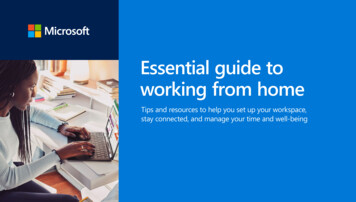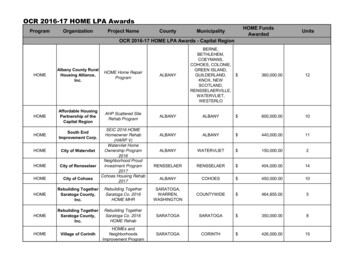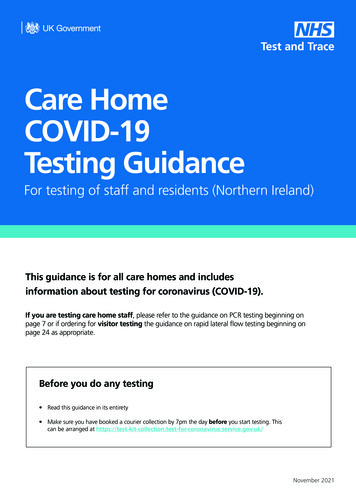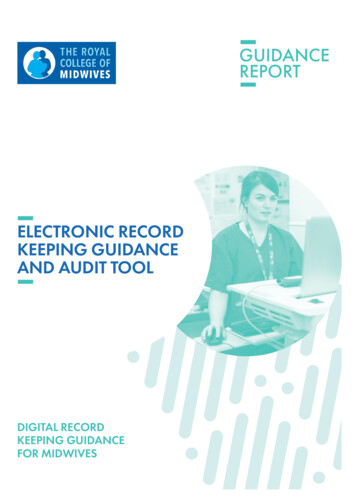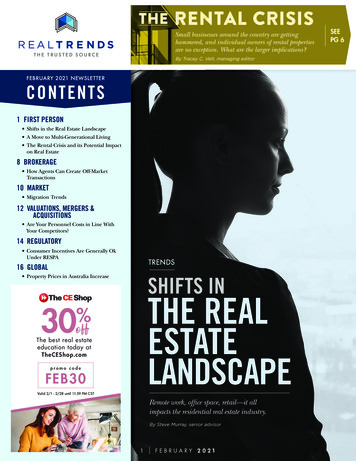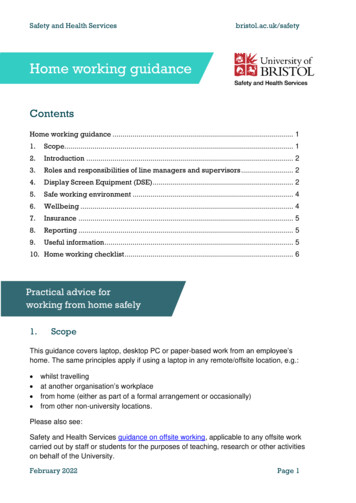
Transcription
Safety and Health Servicesbristol.ac.uk/safetyHome working guidanceContentsHome working guidance . 11.Scope. 12.Introduction . 23.Roles and responsibilities of line managers and supervisors . 24.Display Screen Equipment (DSE) . 25.Safe working environment . 46.Wellbeing . 47.Insurance . 58.Reporting . 59.Useful information . 510. Home working checklist . 6Practical advice forworking from home safely1.ScopeThis guidance covers laptop, desktop PC or paper-based work from an employee’shome. The same principles apply if using a laptop in any remote/offsite location, e.g.: whilst travellingat another organisation’s workplacefrom home (either as part of a formal arrangement or occasionally)from other non-university locations.Please also see:Safety and Health Services guidance on offsite working, applicable to any offsite workcarried out by staff or students for the purposes of teaching, research or other activitieson behalf of the University.February 2022Page 1
Safety and Health Services2.bristol.ac.uk/safetyIntroductionMany staff work flexibly, including remotely at offsite locations and at home. Working athome, either on a laptop, desktop PC or carrying out paper-based work is a low riskactivity. This type of working pattern can offer a range of potential benefits, but there arealso associated hazards. These include: Working in isolation (wellbeing, stress or personal safety and accidents).Aspects of the work environment like display screen equipment (DSE), fire safety andelectrical safety.This guidance provides practical advice on steps to take to ensure work at home iscarried out in a healthy and safe way. There is also a checklist at the end which can beused by staff to consider the safety of their home working environment.3.Roles and responsibilities of line managers and supervisors Ensure there is adequate contact and communication with home workers.Ensure risks associated with home working are covered by the local safetymanagement system. This might include DSE assessments and making sure homeworking is covered by the local rules.There is generally no need to visit a homeworker attheir home unless a specific concern has been raised.4.Display Screen Equipment (DSE)Setting up your workstation correctly at home is equally as important as when you are inthe office, and the same principles apply. Your workstation includes your desk or table,chair, and PC or laptop. Safety and Health Services has a range of online informationabout DSE, including: DSE e-learning module with advice on setting up your workstation correctly whereveryou work. This should be completed every 12 months.DSE risk assessment overview flowchart: gives an overview of the DSE process andthe steps you need to take to work comfortably in any locationVisual checklist for setting up your workstation correctly. To be used each time youwork at a new workstation.DSE self-assessment: only complete this if you are still experiencing difficulties aftercompleting the steps outlined in the DSE risk assessment flowchart. Completed formsshould be submitted to your local DSE assessor.February 2022Page 2
Safety and Health Servicesbristol.ac.uk/safetyIf you are experiencing pain or discomfort after completing the actions outlined in theDSE risk assessment flowchart, or have an underlying health condition which is affectingyour work, complete the DSE self-assessment and submit this to your local DSEassessor and line manager.Whilst it may seem easier to simply open the laptop and start working without makingany adjustments, this can lead to poor posture, which can cause pain and discomfortover time. It is well worth taking a couple of minutes to set up your workstation correctlyeach time you sit down to work. The e-learning module and visual checklist will help youdo this.Tips for working on a PC or laptop at home: Raise your screen:Make sure your screen is set so that the top of the screen is at eye level. Somemonitors have built-in height adjustments, or this can be done using an adjustablelaptop stand, a box or some books if necessary. Use a separate keyboard and mouseThis allows the laptop screen to be positioned correctly. Report pain or discomfortIf you feel discomfort, report it to your line manager as soon as you notice it. In somecircumstances, an opinion from or referral to the Occupational Health Service may beappropriate. Adjust your chair heightYour arms should be at right angles, with forearms horizontal and lightly supported bythe work surface. You may need a footrest if your feet are not firmly on the floor. Make sure the lower back is well supportedSupport for your lower back will help encourage good posture. A good supportiveadjustable office chair can provide this. As a temporary measure you can also use afolded towel to give you more support or consider a back-support cushion if needed. Take regular, short breaksMove around for five or ten minutes every hour, aiming for frequent, short breaks.Consider taking microbreaks to stretch, move around, change activity by taking aphone call, do some reading or get a drink to avoid prolonged static postures.Take more frequent breaks if your DSE setup is not optimal or if you are experiencingdiscomfort.February 2022Page 3
Safety and Health Servicesbristol.ac.uk/safety Request equipment for working at home if blended working has beenadopted.Further information on how staff can do this can be obtained from Safety and HealthServices.Try to avoid: 5.using phones or tablets for a long time,sitting on unsupportive seating such as a sofa,static postures.Safe working environmentFire and electrical safety Make sure you have smoke alarms fitted and check these regularly.Do not overload sockets adaptors. Avon Fire and Rescue has a useful online tool tohelp you decide if you are overloading a socket.Carry out regular visual checks on plugs, cables and electrical equipment. Do not useitems which have damaged casing, cables, plugs, scorch marks or other signs ofdamage. Further information is available from the Health and Safety Executive.Ensure University-owned electrical equipment has been PAT tested (it should have asticker confirming this).Emergencies (including first aid) Make sure you have access to basic first aid provisions.Have an emergency plan including what to do if there is a fire.Report work related accidents and incidents to Safety and health Services (please login with VPN to access this).General working environment Give yourself enough space to work comfortably and move around.Ensure your work area is free from trip hazards like trailing cables, bags or otheritems etc.Make sure there is adequate lighting, temperature, and ventilation.N.B. Please use the home working checklist at the end of this guidance to assess yourhome working environment.6.WellbeingThe University has a range of guidance and support for staff on wellbeing. Additionalinformation can also be found on the University’s PositiveWorking@Bristol web page.February 2022Page 4
Safety and Health Services 7.bristol.ac.uk/safetySchool and services should have a team/departmental preventative work-relatedstress risk assessment taking remote and lone working into consideration.Concerns relating to wellbeing at work should be discussed with your line manager.Refer to the work-related stress guidance to complete a risk assessment.InsuranceInsurance arrangements for the University of Bristol will extend to home workers, subjectto the conditions of the policy. Details of the University’s insurance arrangements can befound on the insurance office website.Please note that your home insurance may be affected by having to work from home fora prolonged period. Staff should check this with their home insurance provider.Some staff may have particular conditions in mortgage or tenancy agreementsprohibiting them from using their home for business purposes without prior permission.Staff should check the terms of any agreement and inform where appropriate.Check with your home insurer to ensure that homeworking does not invalidate your own policy8.ReportingAccidents, near misses and incidents of ill health should all be reported in the usual wayusing our online incident reporting system.To use the reporting system from home, enable the University’s IT network on yourlaptop, just like you would in order to access any other on-campus services, either byusing the Student Remote Desktop and Staff Remote Desktop services or setting up theUoB Virtual Private Network (VPN).9.Useful information1. Health and Safety Executive information on home working2. Chartered Institute of Ergonomics and Human Factors infographics on homeworkingand staying healthy3. DSE e-learning module4. University lone working guidance5. University DSE guidanceFebruary 2022Page 5
Safety and Health Servicesbristol.ac.uk/safety6. University’s Insurance Office website7. HR flexible working8. General risk assessment guidance9. University information on work-related stress10. IOSH remote working guidance11. PositiveWorking@Bristol12. Setting up IT services for working at home10.Home working checklistUse this checklist to identify any possible hazards in your home working area. Oncecompleted, this checklist can be used in discussion with your line manager to confirmworking arrangements and help you complete a risk assessment.Employee:Home workplace location: or XCommentsA: Working environment1. Is there adequate space in the area you are working in towork safely?2. Is your working area free from tripping hazards (eg, trailingcables)?3. Are objects like equipment, bags, paper, files and booksstored safely?4. Is there an adequate working temperature (Minimum 16 C)?5. Is there adequate lighting?B: Display screen equipment1. Have you completed the DSE e-learning module?2. have you printed / are you using the DSE visual checklist?3. Have you completed a DSE self-assessment form coveringyour workstation(s) including home (only if applicable)?C: Emergency actions1. Do you have access to basic first aid provisions?February 2022Page 6
Safety and Health Servicesbristol.ac.uk/safety2. Do you know what to do in an emergency, and have youworked out a fire drill so you and anyone else in the houseknows what to do and where to go in case of a fire?3. Are smoke detector/s fitted?4. Are you familiar with the University procedures for accidentand incident reporting?D: Electrical safety1. Are University-owned portable electrical appliances PATtested with a sticker applied?2. Do you carry out frequent visual checks on plugs, wiring andcasings of electrical equipment?Employee signatureDate:Line Manger /Supervisor’s signatureDate:February 2022Page 7
12. Setting up IT services for working at home 10. Home working checklist Use this checklist to identify any possible hazards in your home working area. Once completed, this checklist can be used in discussion with your line manager to confirm working arrangements and help you complete a risk assessment. Employee: Home workplace location:


